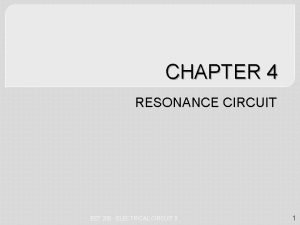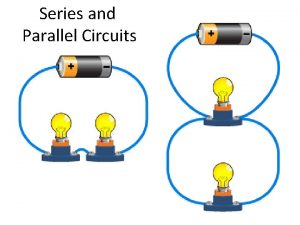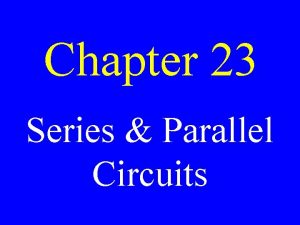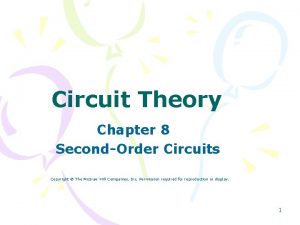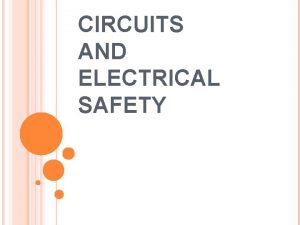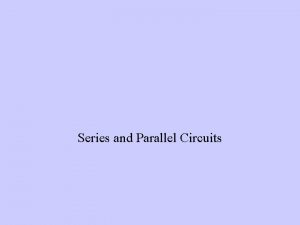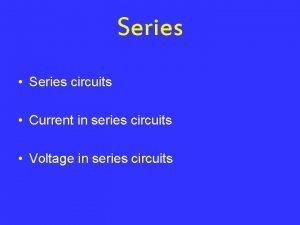Circuits Series Circuit l A circuit with only












- Slides: 12

Circuits

Series Circuit l. A circuit with only one path for the electrons to flow.

Parallel Circuit l. A circuit with multiple paths for the electrons to flow.

Kirchoff’s Laws of Circuits Kirchoff’s Voltage Law l Based on Law of Conservation of Energy l V=W/q l Potential difference is related to energy and work. l The total voltage drops (energy used) must be equal to the total energy supplied in the circuit

Kirchoff’s Current Law l Based on conservation of charge. l The total current going into a junction must be equal to the current going out of the junction. 2 A 3 A 1 A

Mountain River Analogy Circuits are like mountain rivers. No matter what path they take the distance from the top of the mountain to the plain is the same and the amount of water flowing down the mountain is the same. l When a river splits into two paths that is like a parallel circuit. The total amount of water is equal to the sum of the water flowing in each path. l A resistor would be like a narrow section of the river that causes rapids. l A battery is the potential energy based on the height on the mountain that the river starts. l

Series Circuit Since there is only one path for the current with no junctions, we can say the current (I) remains constant throughout. IT = I 1 = I 2 ……. . l The equivalent resistance is the sum of all the resistances. Req = R 1 + R 2……… l Since voltage drops occur across resistances, the sum of the drops equals the total voltage supplied l VT = V 1 + V 2 ……. .

Parallel Circuit l The potential difference (V) will remain the same across all paths. VT = V 1 = V 2 = V 3 …… l Based on Kirchoff’s Law, because there are many junctions, the current into the junctions equal to the current coming out of the junctions. IT = I 1 + I 2 + I 3 …. .

Resistance in a Parallel Circuit Combining parallel circuit laws with Ohm’s Law, we can formulate an equation for the equivalent resistance of a parallel circuit. 1/Req = 1/R 1 + 1/R 2 + 1/R 3 …. . Based on Ohm’s Law l I 1 = V 1/R 1 I 2 = V 2/R 2 I 3 = V 3/R 3 Applying Kirchoff’s Law l VT/Req = V 1/R 1 + V 2/R 2 + V 3/R 3 Since voltage is constant at any point in a parallel circuit. l 1/Req = 1/R 1 + 1/R 2 + 1/R 3 l

Measurements in Circuits l Voltmeter - must be wired in parallel. Measures the drop in potential difference across the two leads l Ammeter - must be wired in series with the circuit. Will measure the current in that leg of the junction. l Resistance - must be calculated based on voltage and current readings.

Series Practice Two resistors, 47. 0 ohms and 82. 0 ohms, are connected in series across a 45. 0 V battery. a. What is the current in the circuit? b. What is the voltage drop across each resistor? l

Parallel Practice Three resistors 60. 0 ohms, 30. 0 ohms, and 20. 0 ohms are connected in parallel across a 90. 0 V battery. a. Find the current through each branch of the circuit. b. Find the equivalent resistance of the circuit. c. What is the current from the battery? l
 Advantages of parallel circuit over series circuit
Advantages of parallel circuit over series circuit Parallel circuit with 3 bulbs
Parallel circuit with 3 bulbs Series vs parallel circuit
Series vs parallel circuit Venn diagram of series and parallel circuit
Venn diagram of series and parallel circuit Series vs parallel diagram
Series vs parallel diagram Series and parallel circuits
Series and parallel circuits Bill nye electricity worksheet
Bill nye electricity worksheet Series circuit facts
Series circuit facts Circuits
Circuits Chapter 23 series and parallel circuits answers
Chapter 23 series and parallel circuits answers Lesson 8: comparing series and parallel rlc circuits
Lesson 8: comparing series and parallel rlc circuits Every circuit must have
Every circuit must have Differences between series and parallel circuits
Differences between series and parallel circuits





